Archive for the ‘Fun’ Category:
NY Times Digits Archive
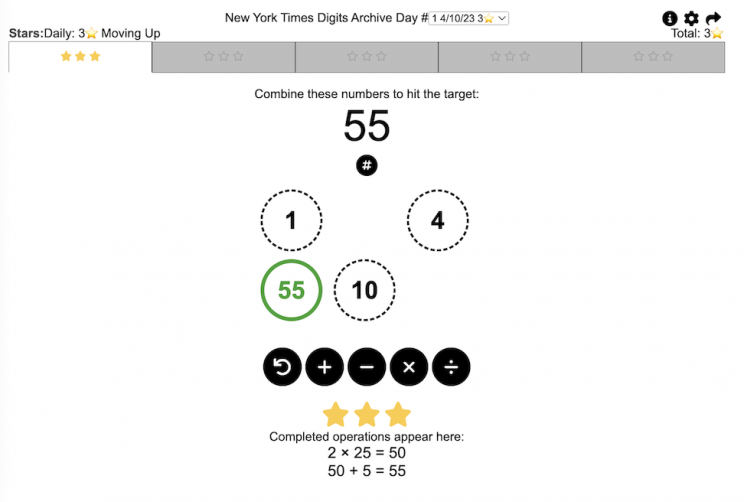
Now play all old Engaging Data Digits puzzles plus 120 archived Digits puzzles from the New York Times
You can still play the NYT Digits Game
Missing the NYT Digits game? You can still play (or replay) the old puzzles here.
On August 8th, 2023, the New York Times ended the beta for their Digits math game and the game is no longer playable. The game ran from April 10th to August 8th and there were 120 different daily puzzles during that time.
Twitter user @Digits_Analysis had compiled a list of each of the five daily puzzles during that entire time period (600 puzzles total) and generously provided them to me. Since I already coded up a Digits replacement with daily puzzles, I figured I could adapt that code fairly easily to make a version where you could play old puzzles. The first 120 puzzles are the original NY Times puzzles and subsequent puzzles are the collection of new daily puzzles.
Rules
The rules for Digits are relatively simple just like in the NYT version. Each day’s puzzle has 5 individual puzzles to complete. Every puzzle has a target number and 6 individual starting numbers that you must use in mathematical calculations to try and create the target number. Each of the 6 numbers can only be used once but the answer to a given math calculation becomes a new number to use.
Once you finish one puzzle, you can use the tabs at the top to move to another puzzle.
Scoring
You get up to 3 stars for each puzzle:
3 stars if you match the target
2 stars if your number is within 10 of the target
1 star if your number is within 25 of the target
Other
Auto-Advance – Click on the gear to toggle on and off “auto-advance”. When enabled, the game will cue up the next puzzle if you hit the target.
Chainmode – Click on the gear to toggle on and off “chainmode”. When enabled, it will automatically highlight the answer from the previous calculation to be the first number in the new calculation.
Share – Share your Digits stars on social media using the share button, which will copy your results to your clipboard. It will share a link to the specific puzzle you are on.
# button – clicking the # button lets you see the total number of possible solutions as well as the fewest and most operations that can yield a solution. This can bring an extra element of challenge to the game. See if you can achieve the shortest solution and then try again to achieve the longest solution. Clicking on the buttons reveals one of the solutions that have the fewest and most number of operations.
Tracking your plays – Digits archive will keep track of your stars for all of 120 daily puzzles. Given that there are 120 old Digits puzzles to play, it may take folks many days, weeks or even months to go through these puzzles. One issue is that on the Safari browser on Macs and iOS devices, the data storage used to track your progress through these puzzles may be deleted if you don’t play the game for 7 days. The browser does this for privacy concerns. Just be aware that your data could be deleted by the browser if you are using Safari and don’t play at least once for 7 straight days. This shouldn’t be a problem for other browsers.
Hopefully you’ll find this enjoy playing the old NYTimes Digits math game and find it a fun and interesting way to improve your mathematical thinking. Let me know if you find any bugs or have any suggestions.
Tools
Python code was used to generate the puzzles and the game play and visuals were created in javascript, CSS and HTML. The New York Times Digits puzzle data was obtained from @Digits_Analysis

Wordle Stats – How Hard is Today’s Wordle?
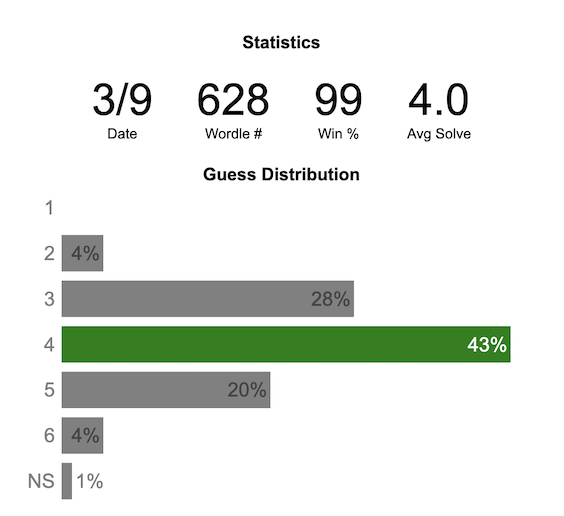
Update: Just added the ability to look at some previous puzzles (since I started downloading the data from the Wordlebot). Also, you can now view the answers of the puzzles if you click on the eye icon.
What is the distribution of guesses for the daily Wordle?
Wordle is a game of highs and lows. Sometimes your guesses are lucky and you can solve the puzzle easily and sometimes you barely get it in 6 guesses. When the latter happens, sometimes you want validation that that day’s puzzle was hard. This data viz lets you see how other NY Times Wordle players did against the day’s puzzle.
The graph shows the distribution of guesses needed to solve today’s Wordle puzzle, rounded to the nearest whole percent. It also colors the most common number of guesses to solve the puzzle in green and calculates the average number of guesses. “NS” stands for Not Solved.
Even over 1 year later, I still enjoy playing Wordle. I even made a few Wordle games myself – Wordguessr – Tridle – Scrabwordle. I’ve been enjoying the Wordlebot which does a daily analysis of your game. I especially enjoy how it indicates how “lucky” your guesses were and how they eliminated possible answers until you arrive at the puzzle solution. One thing it also provides is data on the frequency of guesses that are made which provides information on the number of guesses it took to solve each puzzle.
I play in the mornings so the graph data will be updated every day at 7am Pacific Time.
Data and Tools
The data comes from playing NY Times Wordle game and using their Wordlebot. Python is used to extract the data and wrangle the data into a clean format. Visualization was done in javascript and specifically the plotly visualization library.

ScrabWordle
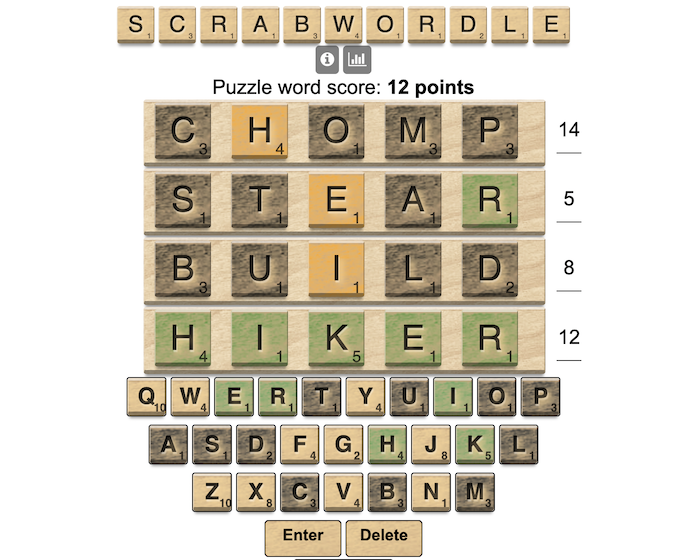
Also try WordGuessr and Tridle
What is ScrabWordle? Wordle with a Scrabble twist
ScrabWordle is a game based on the hugely popular Wordle by Josh Wardle, where you try to solve a 5-letter puzzle. The Scrabble element of the game comes in where the point value of the target word is given based on the letter values in the game and is another helpful clue to help solve the puzzle.
I recently made WordGuessr and Tridle. So I’d already made the structure of the game and just needed to add the Scrabble elements. And it took me a little while to work out all the kinks and it also improved my CSS skills to get all the aspects of the look of the tiles correct.
How to Play ScrabWordle
If you know how to play Wordle, then the rules are the same:
1) the game reports the point value of the target word
2) just type in a guess and and press ‘Enter’, the score of your guess is updated in real time
3) the game will indicate how good your guess was. If any letter are in their correct position they will turn green, if they are correct but in the wrong place, they turn orange, and if they don’t show up in the word they turn black.
4) guess again, using the clues from the previous word
5) you can share your results with other folks or issue a challenge game
6) play all you want
The game is created using HTML, CSS and Javascript code to create interactivity and UI. Hope you enjoy it. I enjoy the extra element (word point values) to help me guess the word. Let me know in the comments how you like the new game play and if the difficulty levels are appropriate.
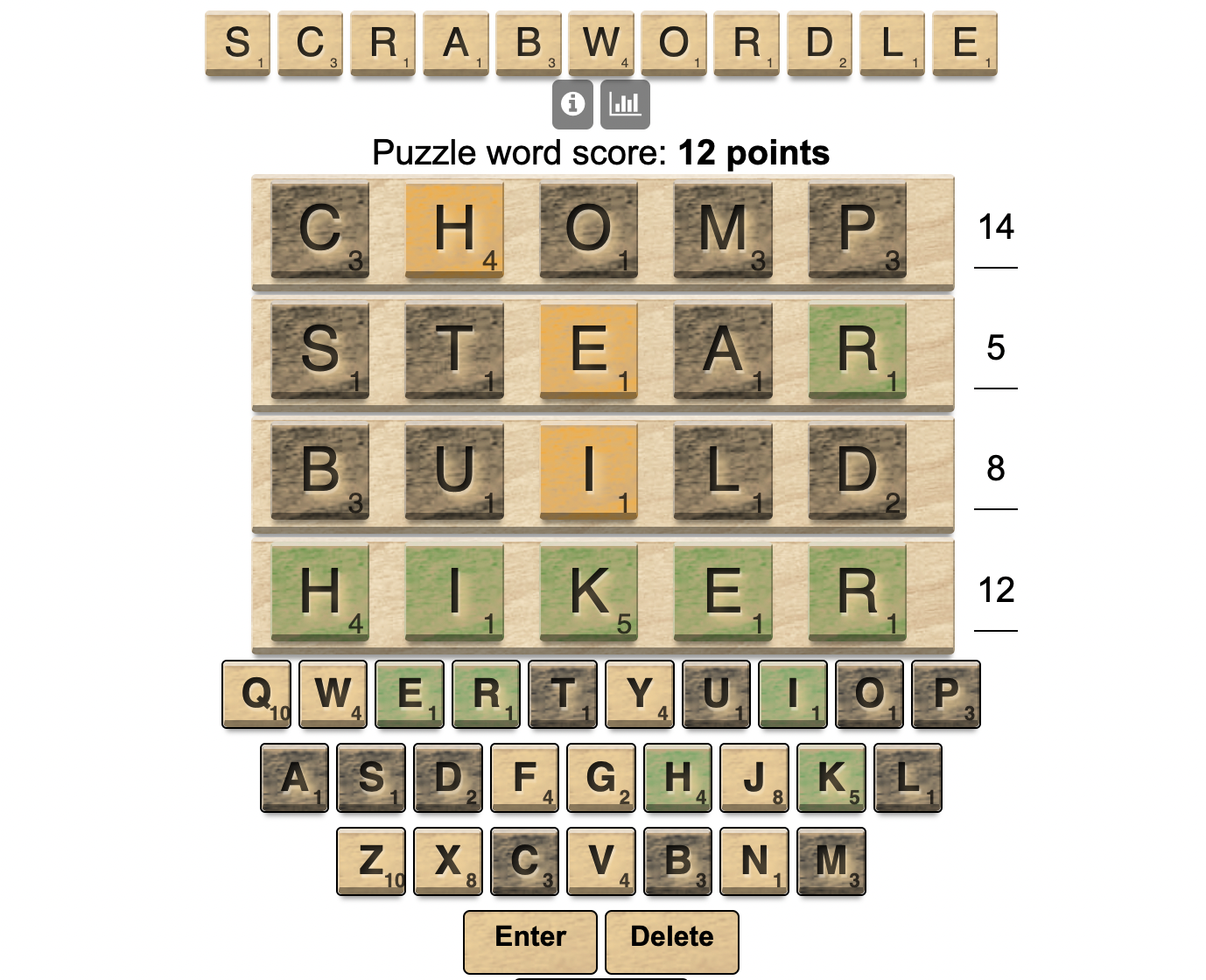
Tridle – a triple Wordle game
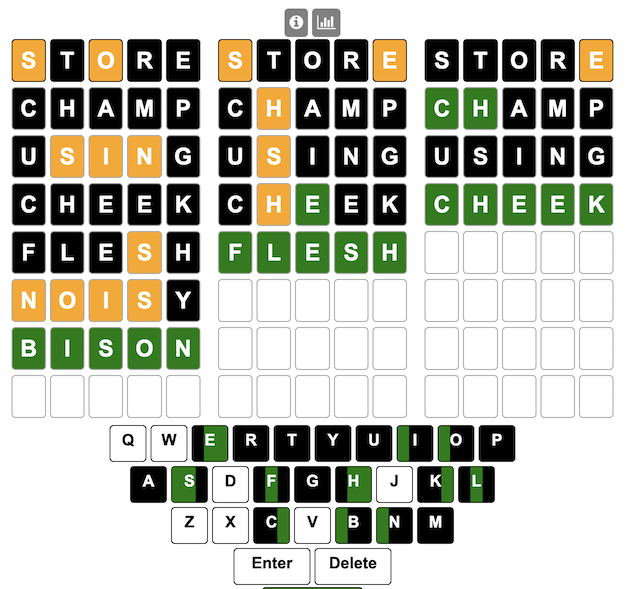
Over 5 Million games played! (December 2022).
Try my clone of the NYTimes game Digits
What is Tridle? Triple Wordle
Tridle is a game based on the hugely popular Wordle by Josh Wardle, where you try to solve three puzzles (Triple Wordle) at the same time. It is also modeled after Dordle and Quordle, but a little different (3 instead of 2 or 4!)
Shortly after I started playing Wordle in early January, I wanted to play more games so I decided to make a Wordle game so I could play as often as I wanted. I made WordGuessr in a day or so. It ended up being fairly popular and lots of people still play.
Recently, I started playing Dordle (where you solve two puzzles simultaneously), which adds an extra layer of challenge onto the Wordle game. I thought that a triple Wordle game would be a fun game to code up and since I’d already made the structure of the single game, how hard could making 3 be. Well, it took me another day or so to work out all the kinks and it was also stretched my CSS skills to get all the look correct with all the various permutations of the game and generating three boards simultaneously.
If you know how to play Wordle, then the rules are the same:
1) just type in a guess and and press ‘Enter’.
2) the game will indicate how good your guess was for each puzzle separately. If any letter are in their correct position they will turn green, if they are correct but in the wrong place, they turn orange, and if they don’t show up in the word they turn black.
3) guess again, using the clues from the previous word
4) repeat until you get each of the words correct or fail to figure them all out after 8 tries.
5) you can share your results with other folks
6) play all you want
The game is created using HTML, CSS and Javascript code to create interactivity and UI.

US Baby Name Popularity Visualizer

I added a share button (arrow button) that lets you send a graph with specific name. It copies a custom URL to your clipboard which you can paste into a message/tweet/email.
How popular is your name in US history?
Use this visualization to explore statistics about names, specifically the popularity of different names throughout US history (1880 until 2020). This is a useful tool for seeing the rise (and fall) of popularity of names. Look at names that we think of as old-fashioned, and names that are more modern.
Instructions
- Start typing a name into the input box above and the visualization will show all the names that begin with those letters. The graph will show the historical popularity of all these names as an area graph.
- You can hover (or click on mobile) to bring up a tooltip (popup) that shows you the exact number of births with that name for different years (or decades) and the names rank in that time period.
- It’s best used on computer (rather than a mobile or tablet device) so you can see the graph more clearly and also, if you click on a name wedge, it will zoom into names that begin with those letters.
- You can select different views, Boy names, Girl names or both, as well as looking at the raw number of births or a normalized popularity that accounts for the differential number of births throughout the period between 1880 and 2020.
- If you click the share (arrow) button, it will copy the parameters of the current graph you are looking at and create a custom URL to share with others. It copes the link into your clipboard and your browser’s address (URL) bar.
Isn’t there something out there like this already? Baby Name Wizard and Baby Name Voyager
This visualization is not my original idea, but rather a re-creation of the Baby Name Voyager (from the Baby Name Wizard website) created by Laura Wattenberg. The original visualization disappeared (for some unknown reason) from the web, and I thought it was a shame that we should be deprived of such a fun resource.
It started about a week ago, when I saw on twitter that the Baby Name Wizard website was gone. Here’s the blog post from Laura. I hadn’t used it in probably a decade, but it flashed me back to many years ago well before I got into web programming and dataviz and I remember seeing the Baby Name Voyager and thinking how amazing it was that someone could even make such a thing. Everyone I knew played with it quite a bit when it first came out. It got me thinking that it should still be around and that I could probably make it now with my programming skills and how cool that would be.
So I downloaded the frequency data for Baby Names from the US Social Security Administration and set to work trying to create a stacked area graph of baby names vs time. I started with my go to library for fast dataviz (Plotly.js) but eventually ended up creating the visualization in d3.js which is harder for me, but made it very responsive. I’m not an expert in d3, but know enough that using some similar examples and with lots of googling and stack overflow, I could create what I wanted.
I emailed Laura after creating a sample version, just to make sure it was okay to re-create it as a tribute to the Baby Name Wizard / Voyager and got the okay from her.
Where does the data come from?
Some info about Data (from SSA Baby Names Website):
All names are from Social Security card applications for births that occurred in the United States after 1879. Note that many people born before 1937 never applied for a Social Security card, so their names are not included in our data.
Name data are tabulated from the “First Name” field of the Social Security Card Application. Hyphens and spaces are removed, thus Julie-Anne, Julie Anne, and Julieanne will be counted as a single entry.
Name data are not edited. For example, the sex associated with a name may be incorrect.Different spellings of similar names are not combined. For example, the names Caitlin, Caitlyn, Kaitlin, Kaitlyn, Kaitlynn, Katelyn, and Katelynn are considered separate names and each has its own rank.
All data are from a 100% sample of our records on Social Security card applications as of March 2021.
I did notice that there was a significant under-representation of male names in the early data (before 1910) relative to female names. In the normalized data, I set the data for each sex to 500,000 male and 500,000 female births per million total births, instead of the actual data which shows approximately double the number of female names than male names. Not sure why females would have higher rates of social security applications in the early 20th century. Update: A helpful Redditor pointed me to this blog post which explains some of the wonkiness of the early data. The gist of it is that Social Security cards and numbers weren’t really a thing until 1935. Thus the names of births in 1880 are actually 55 year olds who applied for Social Security numbers and since they weren’t mandatory, they don’t include everyone. My correction basically makes the assumption that this data is actually a survey and we got uneven samples from males and female respondents. It’s not perfect (like the later data) but it’s a decent representation of name distribution.
Sources and Tools:
The biggest source of inspiration was of course, Laura Wattenberg’s original Baby Name Explorer.
I downloaded the baby names from the Social Security website. Thanks to Michael W. Shackleford at the SSA for starting their name data reporting. I used a python script to parse and organize the historical data into the proper format my javascript. The visualization is created using HTML, CSS and Javascript code (and the d3.js visualization library) to create interactivity and UI. Curran Kelleher’s area label d3 javascript library was a huge help for adding the names to the graph.
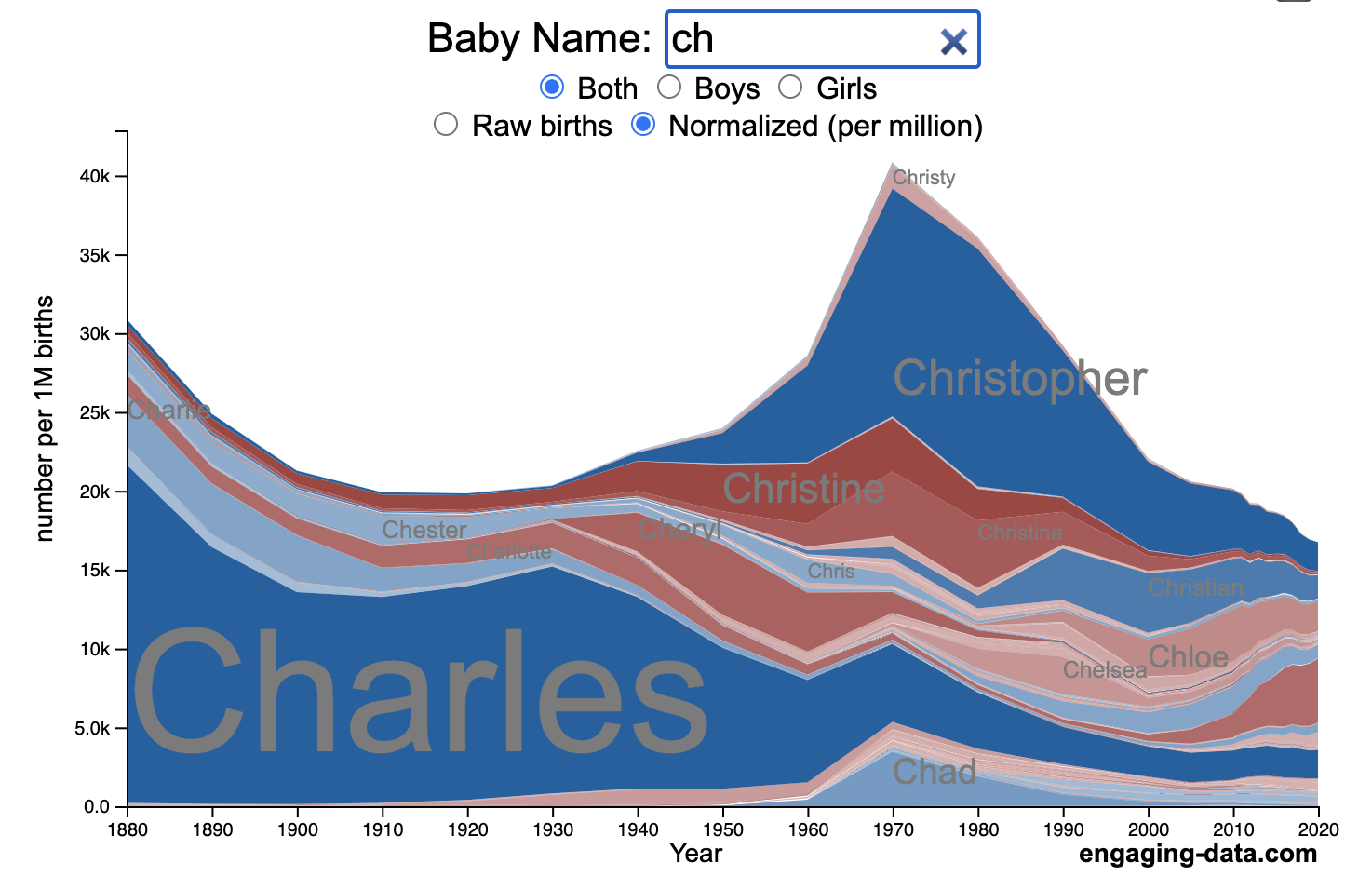
WordGuessr – a social Wordle unlimited clone – Word Guesser
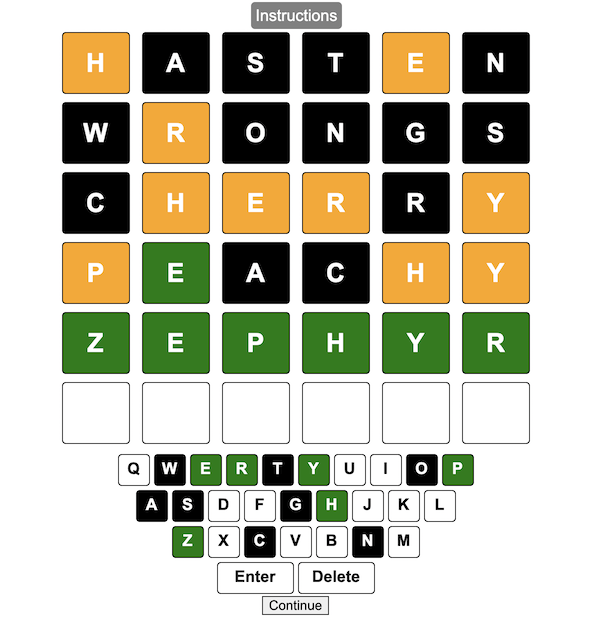
Over 16 Million games played! (Feb 2023).
Try playing my NYTimes Digits math game clone,
TRIDLE – Three Wordle Puzzles simultaneously and

Wordguessr – Unlimited endless Wordle practice
You can do your Wordle practice training here with unlimited attempts.
As my wife likes to say, “Practice makes ‘Pretty Good'”.
I made this Wordle clone in about a day after playing with Wordle for a few days. My wife and I were pretty hooked and I wanted to play more than once a day. It’s like a word version of Mastermind. I also thought it would be fun with words of different lengths, so I added the option for words between 3-7 letters long. Depending on the number of letters, the game feels very different. 3 letters is very short and it’s easier in some respects but you have to guess more. Longer words require much more thinking.
The rules of the game are pretty simple:
1) just type in a guess and and press ‘Enter’.
2) the game will indicate how good your guess was. If any letter are in their correct position they will turn green, if they are correct but in the wrong place, they turn orange, and if they don’t show up in the word they turn black.
3) guess again, using the clues from the previous word
4) repeat until you get the word correct or fail to figure it out after 6 tries.
I added the ability to create a challenge game that allows you to share a link (with a unique code) which will enable anyone with the link to play the same word.
Apparently, my site is unblocked on education websites (which makes sense since it has a lot of educational content), so I seem to be getting lots of traffic from Chromebooks searching for “Wordle Unblocked”.
You can also share your guessing results (not the answer) with a grid of boxes, like the original Wordle, as shown below:
WordGuessr Challenge
(5 letter) 4/6
🟩⬛⬛⬛🟧
🟩🟧🟧⬛⬛
🟩🟩🟩⬛🟧
🟩🟩🟩🟩🟩
Try the same exact puzzle here:
https://engaging-data.com/wordguessr-wordle/?challenge=uab5
I also added the game stats which should persist across games and lets you look at stats for games of different word lengths individually as well as all your games.
I wasn’t sure what how the original Wordle game handles duplicate letters so I made up my own set of rules for how it would happen. First, if there are multiple instances of a single letter (e.g. two ‘E’s in a word) and you make a guess of a word with two ‘E’. If one is in the correct spot and one is in the wrong spot, one will be green and the other orange. If both are in the wrong spot, they will both be orange. If there is only one ‘E’ in the answer but you guess two, one will be black and the other will be green or orange depending on its position.
Sources and Tools:
Obviously a big shout out to Josh Wardle and his Wordle game, as this is mostly a carbon copy of his game with a few additions.
I downloaded the most common words in English from the English Lexicon Project Web Site at Washington University in St. Louis. Then I processed these to remove foreign language words and other strange entries and split them into groups of words by number of letters using Python.
The game is created using HTML, CSS and Javascript code to create interactivity and UI. Thanks to my wife and daughter for beta-testing, lots of fun beta testing.

Recent Comments